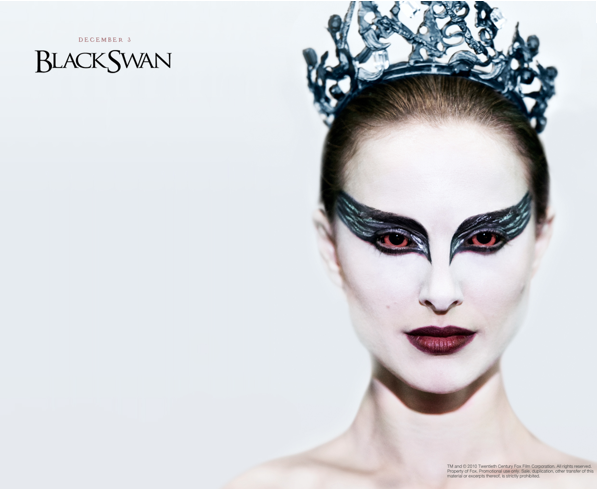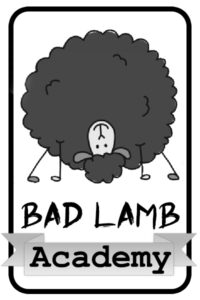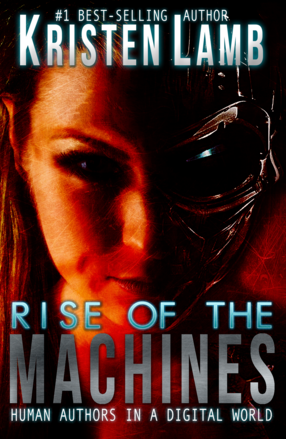It’s now September and we are closing in on NaNoWriMo, so I am going to be posting on some core issues that stump many a new writer. Most new writers do not properly understand the antagonist, and that is a HUGE problem, namely because no antagonist, no story. The antagonist creates the story problem the protagonist must solve/resolve by Act III.
Here’s the rub.
Whenever I blog about the antagonist, I always get, “Well, my protagonist is the antagonist. She is her own worst enemy.” We have discussed this somewhat in earlier blogs. But, in a nutshell for those of you who have slept since we talked about this, virtually all protagonists, at the beginning of the story are their own worst enemies. That is called character arc. If properly plotted, all protagonists would fail if pitted against their enemy in Act One. It is the story that makes our protagonists grow, mature and rise to become heroes and heroines.
Ah, but what if our protagonist literally is the antagonist?
This is when a proxy can be extremely helpful. Even fancy Hollywood directors know that. There will be a character who represents that side that must be conquered in order for the protagonist to be triumphant. One of the best examples of this I have ever seen is the movie Black Swan. Spoiler alert if you choose to keep reading (will try to minimize spoiling the movie if you haven’t yet seen it, but come on! The movie’s been out almost a year and a half).
Anyway…
In the movie Black Swan, the protagonist Nina is very literally at war with herself. She is a high-strung perfectionist who has clearly not been allowed to grow up like a normal young woman. Nina is cast to take the place of an older dancer who is retiring (not so willingly). Nina must embrace the light and the dark, but can this good girl unleash the darkness pent inside, yet keep her sanity?
This is the big question presented in this psychological thriller.
For those not in the know, Swan Lake is basically a tragic fairy tale. A young girl is bound by a curse to become a swan forever, and true love is the only thing that can break the spell. The cursed girl (Odette-the White Swan) finds hope in a young prince, but her evil twin sister (the Black Swan-Odile) seduces him away. Faced with defeat, Odette kills herself.
In the movie, Nina wins the role as the lead in “Swan Lake” and is perfect for the role of the delicate White Swan, Odette, but then progressively loses her mind as she becomes more like Odile, the Black Swan.
Nina does great with uptight, naïve innocence, and is perfect White Swan material. The problem is that Nina’s big life goal is to be perfect, BUT Nina needs to learn that true perfection is a mixture of order and chaos.
The Black Swan is a sexualized role. The Black Swan is a raw, visceral temptress. Nina can’t relate. She is too repressed by her overbearing mother who is living vicariously through her daughter.
Nina is her own worst enemy.
Ah, but here is where proxies come in handy, because a movie with Nina arguing with herself would be weird and probably boring (Hint: In novels this is just as annoying, if not more annoying). Aronofsky and the screenwriters came up with a brilliant solution which had me sitting on the edge of my seat all three times I watched the movie.
Their solution? Lily.
Mila Kunis plays Lily, Nina’s rival for the role of prima ballerina. Nina, coincidentally, has a rather intricate flower tattoo (black lilies) on her back that, in the right light, looks like a set of black folded wings. Lily is everything that Nina longs to be. She is beautiful, wild, carefree, and doesn’t have some weirdo narcissist mother making her go to bed before 9.
If you guys followed my series last year about structure, then you know the antagonist (or a proxy) MUST be introduced before the turning point into Act One.
Normal World–> Inciting Incident–>Turning Point Act One
This is based off the four-part model—Normal World, Act One, Act Two, Act Three. In screenplays, Normal World usually gets condensed right into Act One. In novels the reader needs more time to get grounded; ergo a 4-part structure.
If Nina is her own worst enemy, how can we introduce her as a protagonist AND an antagonist? We can’t. We need a proxy. We need Lily.
How does the director introduce Lily, yet still hint that the core antagonist is Nina? He uses a tad of camera trickery.
Nina is taking the subway into the city. She is wearing a pale pink coat and a white fluffy scarf, her hair up in a prim ballerina bun. Out of the corner of her eye, she spies what looks like her twin, only the “other Nina” is wearing a black coat and dark gray scarf (not so subtle symbol there). Nina never sees her “twin’s” face, only sees that the girl has on iPod ear buds. In every way, though, this girl looks like the photo negative of Nina….her dark “other half.”
In the next scene, we are introduced to Lily and see she has on ear buds. This cues the viewing audience that Lily is the “twin” Nina spied on the subway. Lily is Nina’s “black swan.” Lily is the main antagonist. Lily represents everything that Nina longs to be.
Yet, is Lily the only antagonist? Not by a long-shot.
To really understand the other antagonists in this movie, we need to get to Nina’s core issue. What is Nina’s problem? She longs to grow up but she is afraid, namely because her overbearing mother does everything she can to keep her a “little girl.”
While the director Thomas is daring Nina to explore her sexuality and discover her wild side, Mom is busy buying Nina more stuffed ballerina bunnies for her pink little girl bedroom. Nina is being pulled against to polar extremes.
Repressed naïve little girl vs. wild sexual temptress.
Even though Nina is her own worst enemy, I challenge you to look at each of the scenes in this movie, and there was almost always an outside antagonist driving her arc, exposing the soft and tender parts that Nina was trying so hard to cover. She is a girl who needs to control and the thought of losing control terrifies her. But, to dance the Black Swan, that is exactly what she must do. She must be able to balance order and chaos. She must be able to keep control and lose control all in the same moment.
Can she?
Thomas is pushing her to let loose. He even says, “The only person standing in your way is you.” Mom is doing everything in her power to force Nina to stay a “little girl.”
Lily is showing Nina everything she could be…but isn’t.
The entire movie is a battle of two questions–Is Lily out to get Nina and take her part? Or, is Nina losing her mind? The core question, however, is whether Nina can be both White Swan and Black Swan without fracturing. And that part I will leave out. This is an excellent movie and well worth studying.
Suffice to say that movies have leeway that novelists do not. Nina is pitted toe-shoe to toe-shoe with her rival, Lily. This is where the camera work is very cool. Ever so often, we see Lily, but then there is a flash of Nina’s face…hinting that Nina is pitted against her own darkness that she has tried so hard to keep contained. A darkness, that, once let out of the box, has the power to destroy her.
What can we learn from this? If we can’t use the fancy camera trickery, then why bother studying this movie? Study conflict and scene antagonists.
Thomas and Mom represented the two sides warring for little Nina’s heart and mind. Lily was a brilliant proxy and made for a formidable BBT (Big Boss Troublemaker). In the Big Boss Battle, Nina had to stand up to Lily (the Black Swan) and claim that she could dance both parts. According to narrative structure rules, Nina must utterly defeat/kill the BBT, which she does.
But who dies? Lily or Nina? Watch the movie :D.
As far as a book that explores inner demons, Dennis Lehane’s Shutter Island is one that I would highly recommend for study, and is a very similar psychological thriller. What about you guys? What books or movies would you recommend? What did you like about the movie? What didn’t you like? Are there other movies you would advise we watch for study?
I LOVE hearing from you guys! And since we have a guest today, every comment counts DOUBLE in the contest.
To prove it and show my love, for the month of September, everyone who leaves a comment I will put your name in a hat. If you comment and link back to my blog on your blog, you get your name in the hat twice. If you leave a comment, and link back to my blog, and mention my book We Are Not Alone in your blog…you get your name in the hat THREE times. What do you win? The unvarnished truth from yours truly.
I will pick a winner once a month and it will be a critique of the first 20 pages of your novel, or your query letter, or your synopsis (5 pages or less).
And also, winners have a limited time to claim the prize, because what’s happening is there are actually quite a few people who never claim the critique, so I never know if the spam folder ate it or to look for it and then people miss out. I will also give my corporate e-mail to insure we connect and I will only have a week to return the 20 page edit.
At the end of September I will pick a winner for the monthly prize. Good luck!
I also hope you pick up copies of my best-selling books We Are Not Alone–The Writer’s Guide to Social Media and Are You There, Blog? It’s Me, Writer . And both are recommended by the hottest agents and biggest authors in the biz. My methods teach you how to make building your author platform FUN. Build a platform and still have time left to write great books.









46 comments
9 pings
Skip to comment form
Great post! I agree that The Black Swan is an excellent example, and your explanations are fantastic. Thank you!
I’ve always been one to create my antagonists first. Where they came from, what makes them tick, what they want to prove to everyone else. I get my protagonist by figuring out who could put a wrinkle in his plans without it being someone expected. I figured it was only natural since heroes are just everyday people as long as nobody threatens their lifestyle or those dear to them. Great post.
Excellent. Sharing this.
Ok, having just watched this movie (and wishing I hadn’t), I was a little leery. But as it turns out, I’m thankful I took the plunge. I needed some extra direction on antagonist/protagonist insight 🙂
This is slightly off topic but still on topic with regards to antagonists. Can the antagonist be dead? Can the antagonist be someone the protag idolized in life only for the protag to uncover dark secrets about him after his death?
Excellent post! That movie gave me the creeps, but I agree it was a good example of the antagonist proxy. This helped me understand Inception a little better too! I just watched it for the second time and finally understood the story well enough to dig deeper. It’s similar to Black Swan because the protagonist may or may not be going crazy. The camera trickery helps us to navigate the story, but also works to throw us off balance. Is Cobb in a dream or reality? Is he losing his mind? The BBT does have a proxy through his wife Moll and I hadn’t realized that until reading your post. Thanks!
I saw Black Swan wen it first came out and I think you chose a brilliant example of a character at war with themself. And you’re right about the movie being able to SHOW different aspects of Nina’s struggle whereas in writing, showing flashes of a character’s alter ego might be a it more difficult.
Recently my husband and I started watching Perception with Eric McCormack. We love the show and like the way Dr. Daniel Pierce, a nueroscience professor who teaches college courses is also a paranoid schizophrenia. Basically, Pierce’s mind is brilliant, but it’s also damaged, so even though he’s helping the FBI solve crimes he’s also fighting other battles…against the voices in his head and the imaginary people populating his world.
Great post Kristen!
Have a wonderful evening,
Tamara
“Virtually all protagonists, at the beginning of the story, are their own worst enemies. That is called character arc.” Yours is the clearest, most precise definition of character arc that I’ve read. Mostly, thank you for such a thorough examination of the true meaning of “my protagonist is my antagonist.” Crisp and clean, here is yet another jewel for your crown, Kristen.
Karen
Wow, had not even thought of that. Scuttling back to my plot outline now, to see what I might do with it here … and have saved a precis of what you wrote for myself, to remind me that it might be useful later.
Just remembered that Fight Club is another example of this proxy.
Despite mixed reviews (mainly from ballet dancers complaining about the presentation of the dance world) I’ve been meaning to watch Black Swan for ages, but haven’t got around to it. I know my local library has it, so I’ll probably get it out next time I’m there. My parents wouldn’t let me see it in the cinema because I was only just 15 at the time and they’d heard it wasn’t suitable. Ehehe. If only they knew…
Anyway, this is still very informative. And when I watch it, I’ll be keeping this all in mind.
A question – when writing a crime novel where the murderer is kept hidden until the very end, is the key to having conflict just to make everyone get in the way of the protag? Because you can’t reveal the murderer to have an antag throughout the book, so you’re going to need others, aren’t you? I’m thinking of writing a murder mystery for NaNo this year, and was looking for advice on the whole antag thing, as you seem good at that.
I recommend Ripley’s game or any of the Patricia Highsmith books that are based on the Talented Mr. Ripley. I read all of the books and actually rooted for the antagonist/protagonist who was evil but had morals which was an oxymoron in itself. The first book based on the movie with Matt Damon made you feel kind of sorry for Mr. Ripley and detest the Jude Law character. Yet as Mr. Ripley lives the rich life on the deaths and murders of others, you can have a somewhat interest in what he get away with next. Now in Ripley’s game, he begins to have a more conscience and actually begins to help others and be a protector even though he still kills the badder guys since he’s consider a bad guy.
Great article, Black Swan is one of my favourite films, so it was great to read this and see it studied as a tool to improve writing!
(Also to Kim- another brilliant example to mention Inception!!)
What a great post! I saw the movie Black Swan and hated it! I wondered why Natalie Portman won the Academy Award for “Best Actress” when I fell asleep in the middle of the movie. That was the year that 10 movies were nominated for “Best Picture” and my goal was to watch all 10 movies before the Academy Awards were televised on TV. I actually saw 9 of the 10 movies – Black Swan was the only one I did not watch before the Awards show aired because the movie was no longer playing in the movie theaters and had not been released on DVD. I ended up renting it on DVD when it was released and I did not like it.
But now after reading your post, I think I will go back and watch it again. Some of my favorite movies are intense dramas, for example American Beauty and The Descendants but I also love Airplane and Grease!
Thank again for such a great post!
Leslie Doan
leslieinlittlerock@blogspot.com
I thought Black Swan was great (though there were times when I wasn’t sure what was going on), and I agree that it’s an excellent example of the ‘protagonist against themselves’ idea.
I was wondering how a movie like ‘Rocky’ would fit into that mold. His ‘official’ opponent is Apollo Creed, but it seems to me that Creed is actually an ‘enabler’, allowing Rocky to fulfill his dream. Isn’t Rocky’s real antagonist his own insecurity (and the doubts of those around him) about his ability to be something more than ‘another bum from the neighborhood’?
Excellent post! Very timely, too, as I’m starting to work on my third novel, where this issue is going to be an important factor in creating my protagonist’s character arc. I spent NaNoWriMo 2011 working on the first draft of the novel, and it was there I realized the protagonist was actually the antagonist. Creating the proxies to highlight this has been an intriguing challenge.
I think Black Swan and Shutter Island are great examples. As a sci-fi fan, I’d also suggest the Battlestar Galactica series from the mid-2000s as another fantastic example where the character development is well thought out. There are amazing twists and turns throughout the series that showed the viewer complex situations where each major character’s motivations are explored in a way that was very compelling. Protagonists turned into antagonists, and vice versa. Watching the plot unfold over those four seasons made it one of my favorite stories of all time! I learned a lot about balancing plot and character.
Your post was refreshingly CLEAR and understandable on this sometimes complex subject! I LOVED the Black Swan for so many reasons, and I felt, during the film, that her mother was arguably her worst antag. since she was the one who had held sway over Nina for so many years. I also loved the fusion of genres: thriller/horror/magical realism.
I loved Black Swan. As a former dancer, I remembered that pressure to be perfect (from everyone) and it’s a hard desire to break. Can Nina accept imperfection and cut loose or will she lose her mind and have a psychotic break? I know I have an opinion on what happened at the end there. Awesome job explaining a very complex film.
I’m 70 percent through the latest novel by Louise Penny, *The Beautiful Mystery*. The antagonist takes my breath away, he is so evil and slick. Penny’s series (Chief Inspector Gamache is the protagonist) set in Quebec is amazing in general but this latest one even more so. Plus an exemplar for what you are saying.
I just watched The Black Swan for the first time this past weekend. I struggled trying to determine where the enemy was, which was the director (writer’s) intention obviously. Having you break it apart here is very helpful. I struggle writing an ugly character or an evil character. I want things to be black and white but I recognize the ugly and evil are possible even in the good character. I’m not yet skilled enough to keep the distinction subtle enough to be interesting.
That movie was genius. Normally, a movie that dark isn’t my taste but like you said, the storytelling was so smart.
I think complex stories like Shutter Island and Black Swan don’t exactly stick to the core structure rules. Many rules are broken in such films, they are closer to art-house and attract fewer audiences as they diverge too much from the classical story blueprints in the spectator’s mind. But that’s why it’s called art. I’m excited about NaNoWriMo (will be my first one)
This is great! I haven’t seen the movie, but I may just have to now! 🙂
I may be crazy, but I’ve found with so many stories the hero/ine has both a male and a female antagonist to challenge them. One is usually the inner conflict antagonist and the other the outer. Has anyone else noticed this?
Thanks for share this view!!! All thumbs up!
Really insightful analysis of the flawed character. I’d like to invite you to check out my site, http://www.ReadThrough.com and tell me what you think? It’s designed for screenwriters and actors alike, and we’re changing the way scripts are shared. At ReadThrough.com, you can SECURELY upload a script and the website performs a read-through! Background music and sound affects are optional. Thanks for your time!!!
Another example of the protagonist representing the dark side of the antagonist: Jane Eyre. The crazy woman in the attic is her secret lustful side, no?
Proxies…hmm…
In my novel, Manifestation Files, there are technically two antagonists: the character that drives the plot arc that doesn’t surface until the second half–and the co-protagonist. The co-protagonist is someone the narrator wants to change due to be responsible for the co-protagonist, only there’re a lot more to change than what’s clear in the surface.
Now, would proxies be useful here?
I absolutely loved Shutter Island!
Exceptional movie and starring role and I was totally spellbound trying to figure out who was who. To actually write this role must have been extremely complex. It is a good study for character development. I have a male character I am fleshing out at the moment as he is the ‘hero’ but I don’t want him to be too much of a goodie too shoes either!
I haven’t seen Black Swan, but I’ve heard a lot about it and I really enjoy the themes found there and in Secret Window. In my novel, the antagonist is the main character’s mad grandfather — at least, until we learn that the MC has inherited the madness and it becomes clear that he’s actually more afraid of *becoming* his grandfather. In the meantime, though, grandpa still needs some Big Bad powers that I find he’s lacking in the first draft…
Brilliant post. I haven’t seen Black Swan but it’s now on my To-Watch list.
Many Black Swans ago, when my current agent was not my current agent, but considering taking on the manuscript I’d submitted to her, she strongly suggested I read: Story: Substance, Structure, Style and The Principles of Screenwriting by Robert McKee.
I thought it an odd recommendation since I write novels and not screenplays–until I read it. As with your excellent example of Black Swan, there’s a great deal a novelist can learn from movies, not the least of which is how to write tight–in that every scene works to carry the reader/viewer one step closer to the climax. To avoid filler scenes that do nothing pivotal and go nowhere (regardless of how pretty we’ve written them). To use dialogue as a means for deeper more meaningful characterization, etc.
I leaned a lot from that book (which I borrowed from my screenwriting friend) and the aforementioned agent not only signed me once I’d tidied up my book, but she’s still my agent all these years later. Obviously she knows a thing or two 😀
Author
One of the best books I ever read was Save the Cat, and it is a screenwriting book. Writers should study screenwriting. It helps us understand why what scene comes at what point. helps us understand story contextually.
I did not about the play “Swan Lake” but loved Black Swan movie. Another movie which I loved and has similar protagonist- antagonist thing is Fight Club.
I did not like the book but the movie was amazing.
I LOVE Black Swan and love that you used this movie to showcase inner and outer demons. Absolutely brilliant. 😀
You’ve inspired me to try my hand at fiction, Kristen! Now I need to print out your posts and most importantly, i need to find the time to write…
I don’t want to be branded as the cynic here but I hated “Black Swan,” Mila Kunis’ character was vastly more interesting. Like AsheX, I loved the movie”Fight Club” although the book didn’t have the same tension and the ending was even more anticlimactic.A literary suggestion is Stuart Woods’ “Palindrome,” set in a wonderful place and well done even if it’s a page turner.
Great post. I have an ‘inner demons’ type story coming up, so I am exploring how to get it right. I do prefer to combine external conflict and internal conflict. As you state here, even if the inner conflict is the central point, there must be some external materialization. Not only does it help bounce and play the inner stuff, it offers more opportunity for twists and surprises, and a more definitive resolution.
I will look into Shutter Island.
I remember that post you wrote about antagonists, and it’s a good one. And this is an excellent post. Love the way you handled this subject. I haven’t seen Black Swan yet, but I’ll have to watch it now.
So this is the first time I read your blog, and I find myself intrigued. You make good points regarding how one might be able to have the protagonist be the antagonist through proxy. I didn’t particularly like Black Swan as a movie—not because I didn’t think it was well written or shot well, it just didn’t fit my tastes—but perhaps I should watch it again just to observe what you were talking about. I also have a thing for writing books, so trust that I will be checking out your work. ^_^
Thanks for this post! It was a great read.
Great post. Stephen King is also a master at this.
Wow – this was a great blog post. I really enjoyed reading it. And I do agree with Marcia – Stephen King does an excellent job with this!
I have not seen Black Swan, but now I want to because of this post. I finally saw Shutter Island and it is the kind of movie that makes you think and one you really need to see again to figure out exactly what was happening.
Hello Kristen, I have been struggling with the antagonist / protagonist part of my story. The novel I am working on would seem to have a team of 7 protagonists and 2 antagonists (the antagonists are working together but each have their own agenda).
My questions are:
1. Can there be too many protagonists/antagonists in a story?
2. Can failure or something other than a person be considered an antagonist? The protagonists in my story are constantly failing at their task(s).
Thank you for this! Lots to think about. I receive your blog by email, so don’t often get on here to comment 😉
I wonder how many screwed up individuals there WOULDN’T be if there weren’t screwed up mothers like Nina’s.
[…] Black Swan–The Trick to Inner and Outer Demons. Share this:TwitterFacebookLike this:LikeBe the first to like this. […]
[…] Black Swan: The Trick To Inner and Outer Demons by Kristen Lamb […]
[…] Lamb shows how to use an external proxy when the true antagonist is the protagonist’s own inner demons; Mary Kole examines using reaction as a tool in your writing; and Joanne Wadsworth explains how to […]
[…] Black Swan — The Trick to Inner and Outer Demons by Kristen Lamb at Kristen Lamb’s Blog […]
[…] Black Swan – The Trick to Inner and Outer Demons by Kristen Lamb. […]
[…] Black Swan: The Trick to Inner and Outer Demons by Kristen Lamb […]
[…] 6. http://warriorwriters.wordpress.com/2012/09/17/black-swan-the-trick-to-inner-and-outer-demons/ […]
[…] Black Swan – The Trick to Inner and Outer Demons by Kristen Lamb […]
[…] “For those not in the know, Swan Lake is basically a tragic fairy tale. A young girl is bound by a curse to become a swan forever, and true love is the only thing that can break the spell. The cursed girl (Odette-the White Swan) finds hope in a young prince, but her evil twin sister (the Black Swan-Odile) seduces him away.” ~ Kristen Lamb […]